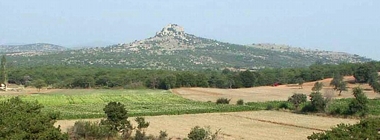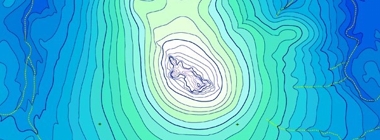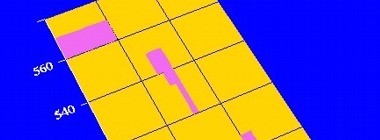The Site
Vrahos is a craggy, tower-like mass of volcanic rock crowning a conical hill in the north-central part of the Petrota graben (Fig. 1). Its main exposed part is 170 m long, up to 55 m wide, and rises c. 20 m above the apex of the hill, to 221 m asl (Fig. 2). The rock is a silicified (hydrothermally altered) dacitoid andesite and is characterized in general by conchoidal fracture. The same silicified rock—we call it “Vrahos silex”—constitutes the bedrock in much of the hill. Adjacent geological units on all sides consist of andesitic rocks of coarser textures and lower cohesion. In contrast with the Vrahos silex, the latter rocks are much weathered and, in hand specimen, they are often friable.
The slopes of the hill below the tower-like feature are littered with prodigious quantities of Vrahos silex gravel, including readily recognizable prehistoric tools, blanks and cores. This silex scatter covers c. 1 sq. km (Fig. 3). Its boundary is in general distinct and it largely coincides, on the one hand, with the boundary of the silicified dacitoid andesite (Vrahos silex) unit and, on the other hand, with the foot of the hill. This suggests that the configuration of the scatter today is controlled by geomorphological factors, that is, slope gradients, erosion, and the different rates of weathering of the local bedrock. It is therefore a poor guide to the spatial extent of human activities in the past.
The density of the lithic scatter varies dramatically across the surface of the hill. It can exceed 100 pieces per sq. m but it can also be as low or lower than one piece per 100 sq. m. This variation is principally caused by two closely interrelated factors, erosion and ground visibility, as we were able to determine through systematic sampling (total collection of surface gravel) and statistical treatment of the samples (Fig. 4). Once again, that is, density is controlled by present (and ephemeral) conditions, and says little about human activities in the past.
In short, in more than 99% of the hill’s slopes, gravel is in the long term downward mobile. Spots of high density are areas where gravel is temporarily trapped. When erosion changes the local micro-topography, gravel may migrate downward, density will change, and new concentrations will form. Areas protected from long term erosion and thus exempt from this rule are few and small.



